|
|
6 KYU - YELLOW BELT (Kiiro - Obi)
|
|
Here you will find all the information you need to prepare you for your grading. This information includes your theory and your practical test. I hope this information helps you in giving you a better understanding about Kyokushin Karate and also gives you a better understanding of your requirements and at the same time helps you to study and prepare for it.
MEANING OF THE BELTS
Below you will find a possible interpretation of the symbolism of the belt colors. I hope this will give a further understanding the sense in which the Obi (belts) colors mean. Belts colors are not only to reflect growth in technique, but also in character.
The Yellow Belt (Assertion)
Yellow is the color corresponding
to the Manipura Chakra, the third spinal centre, whose element is Fire. This
centre is connected by polarity to the seika tanden, the single point in the
lower abdomen so often referred to in Japanese philosophy and martial
traditions. It is the storehouse of psychic creative energy and the physical
centre of balance, situated in the area just below the navel. This general area
of the abdomen is also known as the hara. Students training for yellow belt have
their concentration centred at the hara, and must therefore strive to understand
the principle of generating power through the hips and waist for advancement to
this level. With training, one learns that the power of the punch or kick do not
generate in the foot or the hand. The movement of the striking weapon is of
secondary importance; the all-important generation of power happens at the body,
particularly the hara.
Again at this level it is very important that the students should learn to focus his power by the use of
the "Hara" (Lower abdomen) and the "Tanden" (Point where all the energy is
concentrated, the center of gravity in our body) which is located just behind of
the not of the belt.
The yellow belt requires the student to now give considerations not only
to physical training, dynamic balance and co-ordination, but also to the
psychological aspects of training - perception, awareness, assertion, and other
manifestations of will power.
In the first level of Karate meditation, concentration is centred at the
Manipura Chakra. This unites the body and mind. The Fire element enlivens us and
makes us aware of the dynamic power of the will in Karate. Yellow belt is where
the student applies his intellect and awareness in co-ordinating the basic
physical concepts of Karate with his own mind's immense potential. He becomes
confident in his growing abilities and decisive in his actions. He refines his
Karate knowledge and learns to perform all the movements in a pure and correct
way. dynamic power of the will in Karate
![]()
WHAT YOU SHOULD KNOW FOR YOUR
KYOKUSHIN THEORY TEST
6 KYU - YELLOW BELT -
Below are some vocabulary you should be able to know in order to do your grading.
|
vocabulary |
|
|
Name |
Meaning |
|
Kiiro - Obi Rok-Kyu Yubi Nihon Yohon Nukite Ippon Nukite Nihon Nukite Yohon Nukite Uraken Oroshi Ganmen Uchi Seiken Juji Uke Seiken Jodan Juji Uke Seiken Gedan Juji Uke Haisoku Heisoku Heiko Dachi Hachi ji Heisoku Dachi Heiko Dachi Uchi Hachi ji Dachi Kansetsu Geri / Keri Yoko Kansetsu Geri Yoko Geri Mae Keage Ma-ai Mawatte Enkei Enkei Uke Sashi-te Seishin Ryoku Suri Ashi Tsugi Ashi Kobushi -Do Yonjugo-do Kyuju-do Hyaku-hachiju-do |
Yellow Belt Sixth Kyu Finger(s) Two Four Spear hand Single finger spear hand Two fingers spear hand Four fingers spear hand Backfist Descendent Face Inside Forefist Crossed Block High crossed block or High X block Low crossed block or Low X block Instep (above or top part of the foot) Feet together (Closed) Parallel Stance figure 8 (Japanese) Closed stance or Closed foot Parallel stance Parallel stance Inner figure 8 stance Joint (any joint) Kick Side Kick to the joint Side kick Rising front kick Interval (distance) gap between opponents Turn around Circular Circular Block Extending hand . Blocking and moving forward into opponent and attacks Mental attitude Sliding step Shuffle step Fist Degrees 45 Degrees 90 Degrees 180 Degrees |
Heisoku: Is Japanese for "feet together" (as in "Heisoku-Dachi," Feet-together Stance). Sometimes mistaken for "Haisoku". Literally, a combination of the Japanese character "hei" ("shut" or closed) and "soku" (foot)
Sashi-te: Extending hand . It is a defensive move where one simultaneously blocks, enters into the opponent's range, and attacks.
YOU SHOULD KNOW AND HAVE AN UNDERSTANDING OF:
SOKUGI TAIKYOKU ICHI, NI SAN:
Kicking Katas, has the same movements than the normal Taikyoku but it done with
kicks instead of hands blocking and punches.
Developed by Sosai Masutatsu Oyama en 1980.
YOU SHOULD BE ABLE TO EXPLAIN:
- The meaning of
Yellow Belt
- The Symbols of
Kyokushin Karate
![]()
Below you will find all what you need to know for your grading. It was designed to supply the students with information about theirs requirements for theirs grades. If you have any question regarding the requirements consult your teacher. The grading requirements in our school contain the following:
6th KYU - ( YELLOW BELT )
NOTE:
Please keep in mind that the students must pay the testing fees ($30) 2 weeks before
they give the writing test. the testing fees cover the cost of the Belt
and certificate.
Time in Classes : 14 Months (
Two classes a week - 2 hours class - 3 Month since your Yellow Stripe test )
Theory :
| Students must know the previous syllabuses | |
| Meaning of : Yellow Belt |
| 30 Hands Push Ups | |
| 10 Knuckle Push Ups | |
| 10 Finger Push Ups (5 fingers) | |
| 10 Finger Push Ups (4 fingers) | |
| 10 Finger Push Ups (3 fingers) | |
| 10 Finger Push Ups (2 fingers) | |
| 40 Deep Knee Bends With Front Kick | |
| 1 Min. Rabbit hop | |
| 4 Min. Jump Rope | |
| 1Serie of Abdominal |
Stances - ( Dachi ) :
| Heisoku dachi (Closed Stance) | |
| Heiko Dachi (Open parallel stance) | |
| Uchi hachiji dachi (Inner figure 8 stance) |
Punches - Strikes ( Tsuki - Uchi ) :
| Nihon Nukite (Spearhead/two finger strike) | |
| Yohon Nukite Jodan (Omote) (Spearhead/High four finger strike) | |
| Yohon Nukite Chudan (Tate) (Spearhead/Middle four finger strike) | |
| Yohon Nukite Gedan (Tate) (Spearhead/Lower four finger strike) | |
| Uraken Oroshi Ganmen Uchi (Back fist descending strike to the face) |
Blocks - ( Uke ) :
| Seiken Juji Uke Jodan (High X block) | |
| Seiken Juji Uke Gedan (Lower X block) |
Kicks - ( Geri ) :
| Kansetsu Geri (Kick to the Joint) | |
| Chudan Yoko Geri (Middle side kick) | |
| Jodan Yoko Geri (High side kick) | |
| Mae Keage (Rising front Kick) |
Forms - ( Katas ) :
| Sokugi Taikyoku Sono Ichi | |
| Sokugi Taikyoku Sono Ni |
Combinations - ( Renraku ) :
1.- Using basic techniques (
Kicks and hands techniques, striking and blocking )
Examples:
| Mae Geri / Mawashi Geri / Ushiro Mawashi Geri. | |
| Oi Zuki / Gyaku Zuki / Mae Geri / Mawashi Geri / Ushiro Mawashi Geri . | |
| Mawashi Geri / Ushiro Mawashi Geri / Mae Geri / Mawashi Geri / Ushiro Mawashi Geri. | |
| Oi Zuki / Gyaku Zuki / Mawashi Geri / Ushiro Mawashi Geri / Mae Geri / Mawashi Geri / Ushiro Mawashi Geri. | |
| Soto Uke / Hiza Geri. | |
| Uchi Uke / Hiza Geri. |
Self Defense - ( Goshin Jitsu ) :
| Ippon Kumite ( One-step
sparring)
1.- Application of Shuto Mawashi Uke with suri-ashi (sliding step). 2.- Applying basic Uchi Uke and Soto Uke from Shuto hand position with Kuzuchi finish and counter. Counter should be applied with-Sashi-te, So-ou mai-ai or retreating Tsugi-Ashi (Shuffle step). 3.- Applying basic blocks for wrist grabs from behind using Zenkutso Dachi Mawatte. 4.- Counter technique include all basic striking and leg technique, for grabs from front and back attacks from front. 5.- Knowledge of vital body points for attack. 6.- Enkei Uke/Gyaku Tsuki. | |
| Gyakute (Grappling,
Wrestling, Joint locking) 1.- Releasing technique (tensho) from single wrist grabs (front and back) with counter/follow-up. 2.- Utilizing Zenkutsu Dachi. - Outside one hand wrist grab/Shotei Jodan Uchi - Outside two hand wrist grab/Hiza Geri 3.- Reasonable level of Tai-Sabaki with balance and economy of motion with good Kime, Mai-ai and Seishin Ryoku. | |
| Sparring - ( Kumite ) : 1.- Four Sparring of 2 minutes |
The students should be able to execute the techniques using any of the
stances. Also the students would be tested on any techniques from previous belt.
![]()
STANCES AND WEIGHT
DISTRIBUTIONS (DACHI)
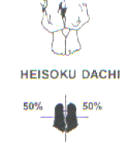 |
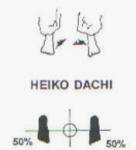 |
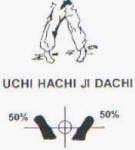 |
| Heisoku Dachi | Heiko Dachi | Uchi Hachi Ji Dachi |
 |
|||
|
NIHON NUKITE |
YOHON NUKITE JODAN | YOHON NUKITE CHUDAN | |
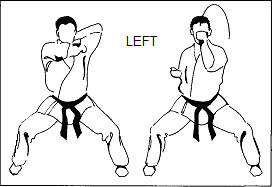 |
| URAKEN OROSHI GANMEN UCHI |
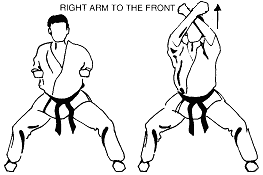 |
|
| SEIKEN JUJI UKE JODAN |
SEIKEN JUJI UKE GEDAN |
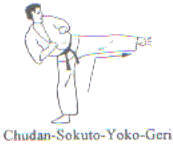 |
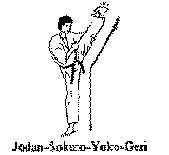 |
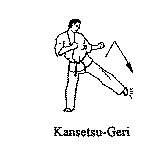 |
|
Chudan Sokuto Yoko Geri |
Jodan Sokuto Yoko Geri | Kansetsu Geri |
GOSHIN JITSU_(SELF DEFENSE)
| 1: OUTSIDE ONE-HAND WRIST GRAB | |||
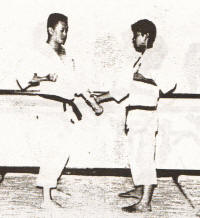 |
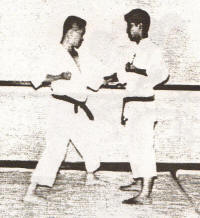 |
 |
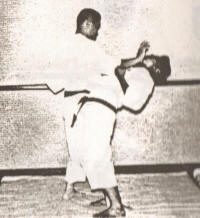 |
| Attacker right hand grab the left wrist of the defender | The defender counter by stepping forward at 45° degree with the left foot while stretching the opponent's arm outward. | Then the defender execute a palm strike to the attacker's jaw with his/her right arm. | Then the defender move his/her back leg (right) behind the right leg of the attacker and follow through by throwing him/her backward. |
| 4: OUTSIDE ONE-HAND WRIST GRAB | |||
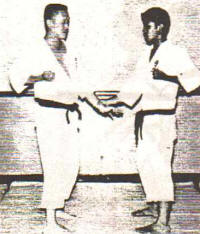 |
 |
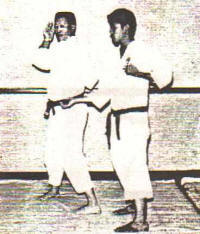 |
 |
| Attacker right hand grab the left wrist of the defender | The defender counter by turning 180° degree to the right (moving your right foot). | Then the defender twist and pull his/her left hand inward. execute a palm strike to the attacker's jaw with his/her right arm. | Then the defender execute a left reverse shuto to the opponent's face. |
![]()
For more information contact
your teacher, sensei Angel Carrasco at:
angel@kyokushincanada.com
GO TO THE MAIN PAGE OF WINNIPEG KYOKUSHIN KARATE - DOJO ENTHEOS